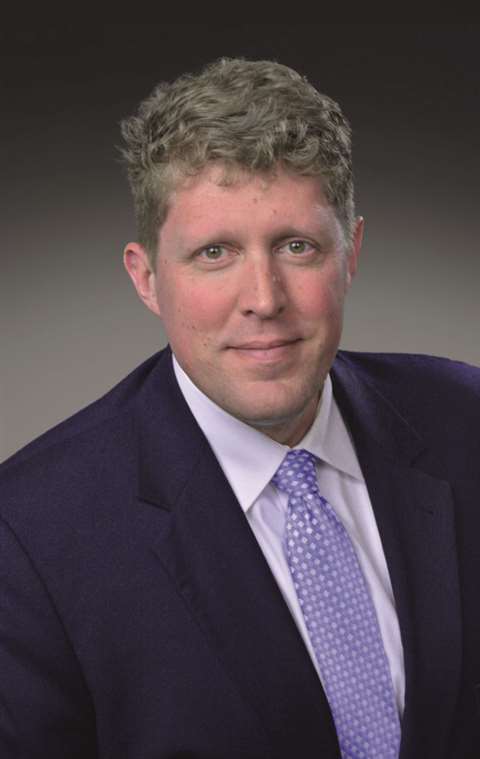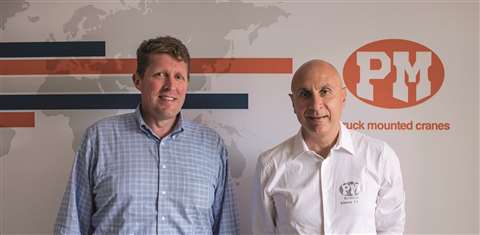Strategic growth: an interview with new Manitex CEO
05 July 2022
Hired as a consultant to identify new merger and acquisition opportunities for Manitex International, Michael Coffey worked with the board and management team to identify, negotiate and close the recent Rabern Rentals transaction. During the diligence process, Manitex Executive Chairman David Langevin and the board realized that Coffey had the business acumen and leadership skills needed at Manitex full time. They wanted him to consider leading the company as its new CEO.
 Michael Coffey, CEO, Manitex International
Michael Coffey, CEO, Manitex International
“We used the acquisition process as an opportunity to perform a protracted interview,” Coffey said. “My appointment occurred when we closed the Rabern acquisition [in April of this year.]”
Coffey brings more than 25 years of experience, primarily in manufacturing and operations management in heavy equipment sales and rentals, including general construction, mining and other specialized industry niches. Having held several senior level positions including CEO and COO, he has a track record as an operations leader integrating, consolidating and managing facilities and executing M&A transactions in the U.S. and abroad.
Coffey seems genuinely enthusiastic about the current state of the company and the tasks ahead.
“We are well-positioned with high levels of talent and very relevant product offerings,” he told me. “Manitex has a very dedicated and talented team. I have been impressed with the passion and level of commitment found with the division leadership at the company. Manitex has a reputable name and has been a longstanding leader in straight mast boom trucks. The company is known for its practical innovations and high levels of customer service.”
Over the past 10 to 15 years, Manitex has acquired complementary products developed for European markets, including the Valla and PM product lines. Coffey said these products are well poised to expand exponentially in the Americas, and specifically North America.
“I would characterize Manitex as well-positioned, reflected in the 50:50 relationship of its backlog between its flagship product and the new articulated and electric powered products,” he said.
“This is significant in the fact that PM, our articulated or ‘knuckle-boom’ line, is just starting to arise as a more significant player in a global market that is several orders of magnitude larger than our legacy North American straight-mast boom truck market. I am excited to be in the position to help the company achieve the financial profile that has long been anticipated, and it’s a credit to the employees, customers and our board that we’ve maintained the Manitex brand, and developed the PM, Oil & Steel and Valla brands to where we can get our share in the multi-billion-dollar global articulated crane market.”
Manitex’s acquisition of Rabern Rentals was another avenue of strategic growth for the company.
“It allows us to add improved marginal contribution to the business, while giving us access to the growing rental industry,” Coffey said.
Coffey and I had a good conversation about Manitex and the path the company is forging ahead. While Manitex has always been known for its successful boom truck product line, Coffey is equally excited about growing the articulating crane, aerial work platform and industrial crane markets.
“Valla is our zero emissions, semi-autonomous or fully operated industrial crane,” he said. “It has capacities well up to the 65-ton and actually 85-ton capability. Our aerial work platforms are both fully electric and/or can be powered by a hybrid module. We are committed to developing solutions which are practical and take advantage of zero emissions where feasible.”
The beauty of the articulated crane is that it folds in its own footprint, offering practical lifting and payload delivery, he said.
“Things are going to change,” he said. “We are going to expand on the articulated side, where the market is really bright. This definitely is a well-received product that is growing rapidly in North America.
Our competitors are doing the same thing, but we hope because we are already strong in North America, we can deliver some creative alternatives to the market to help get this product accepted and tailored for use in better ways.”
In our conversation, Coffey was authentic, articulate and earnest. I think you will be interested in what he had to say about the company and the market for the products Manitex produces.
What are your short-term objectives in taking this new position? Long term goals?
As you might expect, much of the past 60 days has included assessment and review of the entire enterprise. This includes processes, production capacity and critical aspects of the business such as supply chain management. My mandate is to get our returns up to the levels that we’ve promised our investors, which namely, would be EBITDA in the low-double-digit range.
Longer term goals let’s just say I’m looking to do what anyone managing a public company would want to do. I want to see the company grow profitably and generate returns for our shareholders, while also making sure Manitex is a fair, responsible and well-thought of employer in the communities where we operate.
 New Manitex International CEO Michael Coffey and Manitex Italy Managing Director Giovanni Tacconi recently hosted a global dealer conference in Modena, Italy.
New Manitex International CEO Michael Coffey and Manitex Italy Managing Director Giovanni Tacconi recently hosted a global dealer conference in Modena, Italy.
How do you characterize the North American market for boom trucks? What are the challenges for the boom truck market today?
The market is changing with growing reliance on articulated applications, allowing improved urban utilization and tailored solutions. The data would suggest that the boom truck sales peaked during the tail end of the last super cycle (2013 through 2015). There has been a migration toward tailored and articulated solutions, machines which are able to fold up within their own envelope.
There has also been a trend toward larger capacity solutions. Cranes in excess of 80 tons are expensive and bespoke. Our solutions offer maximum capacity on a practice and common delivery platform, the Class 8 truck.
We are often asked about our participation in energy markets, and the straight mast 50 and 55 tonners are great for the oil patch, and while we don’t know exactly where our cranes are going once we deliver them to the dealer, it would stand to reason that we’re seeing increased activities in the energy fields, with oil prices at a relative high. Energy is a very cyclical market and has been critically stress during the post-Pandemic and Eastern European Ukrainian war. We believe routine maintenance as well as global demand for traditional energy sources will favor Manitex in the coming years. However, our future and success will be dependent upon our diversification, not just oil and gas.
What about the PM and Valla product lines? Are they performing as expected? What are the biggest challenges for these product lines?
PM and Valla are our international brands and we’re very excited about both of them right now, and both are performing well at the top line. The challenge is getting them to operate more efficiently and profitably.
What about supply chain issues and component cost increases? Do you see these problems easing up?
Supply chain constraints remain significant issue to Manitex as with any manufacturer. We have long sought to maintain stable costs and pricing. This has been difficult during the past year in particular.
We believe that constraints will lower in the coming three quarters, lowering costs. This is something we are cautiously optimistic about but monitoring very closely.
The current state of the economy is tenuous, although OEMs like Manitex have weathered these storms time and again. What is your strategy operating in uncertain times?
We took on some additional debt with the Rabern acquisition, but we also improved our overall availability and financing structure. We remain aggressive in our pursuit to fulfill production requirements that meet our customer’s expectations. But we are also closely monitoring the overall economy and want to ensure we have adequate reserves and health leverage ratios.
The acquisition of Rabern Rentals was part of a new growth strategy. What will this mean for the company and its product lines?
Consider that our AWPs and both mobile, self-propelled and semi-autonomous units, those product lines are almost solely relegated to the rental industry. The bulk of new orders go to rental companies. It’s the route to market.
We are using Rabern Rentals to have access to and better understand the rental market to design solutions meaningful to the rental business. The acquisition of Rabern gives us the opportunity to have access to the rental industry and take advantage of how that business performs. It will also help us financially from a cash flow perspective. And it will help with product development. Our engineers will be able to work with rental customers to design the products they need.
Rabern is not a channel for our cranes. It’s primarily an alliance for the AWP and battery powered products.
Do you anticipate that Rabern will begin renting boom trucks and articulating cranes from the Manitex line? Will they become a Manitex dealer?
In general, I don’t think that manufacturers make very good distributors. Rabern is a separate entity, a separate company within the Manitex group of companies. We are not looking to compete with our customers, who are dealers, so putting the straight-mast boom trucks in their facilities would not make sense for us, as we are very well served by our current dealers.
Rabern, which is located exclusively in Texas, has a rental fleet for general construction. Rabern carries small utility and construction equipment like (air compressors and blowers, as well as telehandlers, track loaders, smaller backhoes, and work platforms). That said, however, we do think that some of our products are excellent rental products, like the Valla crane and some of our Oil & Steel work platforms. So conceivably, yes, we would see some of our products coming through the Rabern rental network.
What about the Tadano investment in Manitex?
Tadano is an investor that is engaged in the business. We are appreciative of their investment, but our businesses are not integrated. We do have some joint channels. Tadano has a shared office in Italy, and they are marketing their products from that location. Tadano is a great investor in the business, and they have a seat on our board. We are thankful for them.
What is your business philosophy?
I believe that our strategy must be global and highly unified. However, its execution should be decentralized, agile and locally empowered. Such a philosophy enables quick, customer focused reactions and requires an excellent team.
I believe that good people naturally attract good people, which is helpful to a decentralized structure. We need to ensure we have the best people running the business and that they are well supported and empowered by the corporate team.
What do you do when you are not working?
I travel almost every week, therefore, when I am home the majority of my time is spent with my family. I’m fortunate to be married for 27 years and have two highly intelligent and gifted daughters. When I am not working, I’m typically enjoying time with them.
STAY CONNECTED


Receive the information you need when you need it through our world-leading magazines, newsletters and daily briefings.



